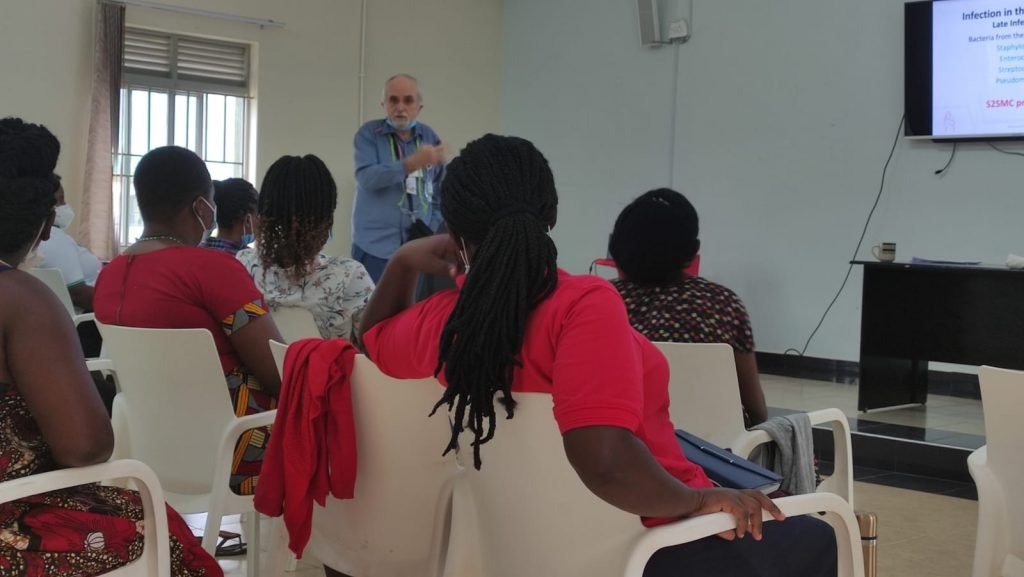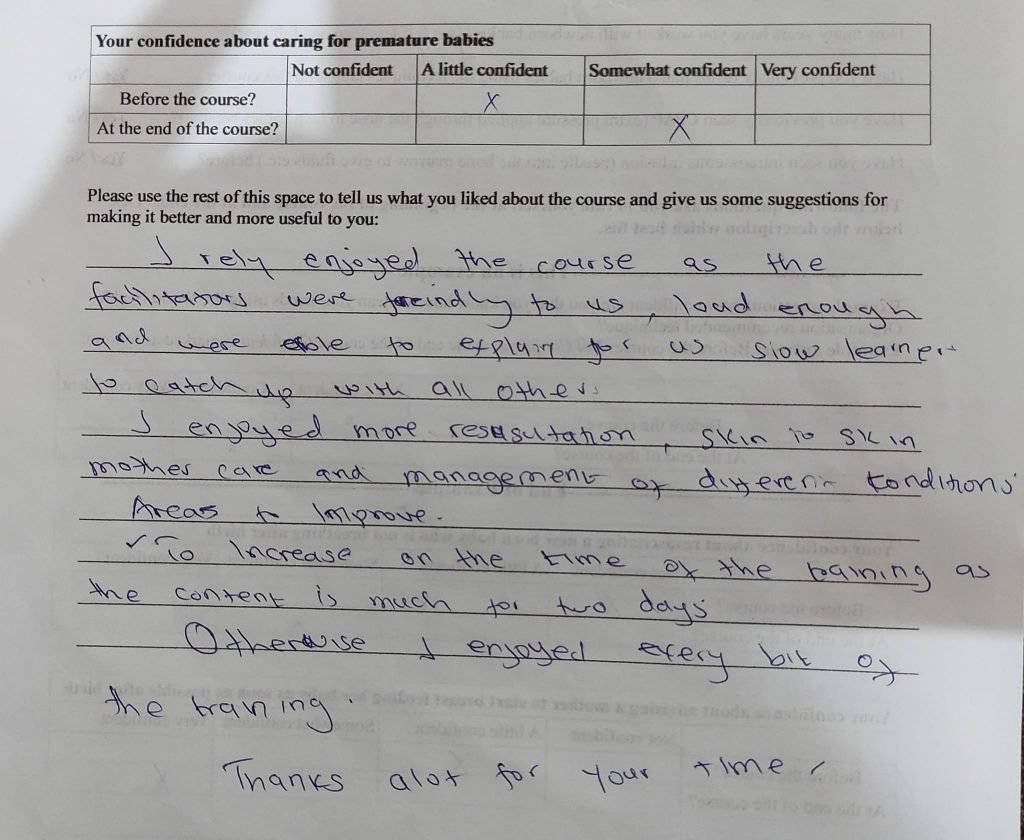
We are back in Entebbe now after 2 very successful Neonatal Care Courses, full of enthusiasm about returning in November to train the instructors we have identified.



We are back in Entebbe now after 2 very successful Neonatal Care Courses, full of enthusiasm about returning in November to train the instructors we have identified.



Keeping babies warm is one of the things that reduce neonatal mortality. We promote it strongly throughout the course. It also promotes breastfeeding, reduces the risk of hospital-acquired infection, is important for bonding and leads to faster growth.


When we went to the neonatal unit initially, there were 5 babies (including a set of twins) between 33 and 35 weeks in incubators or being held by their mothers in piles of blankets. The doctor asked for help because none of them were putting on weight. Grace went to work…

All 5 had been discharged by the end of our week in Bwindi, all putting on weight. Well done to the nurses for being early adopters of KMC in Bwindi and for seeing the benefits straight away.
On day 3 of our visit, we noticed these pictures that had been put up in the anteroom to the neonatal unit where the mothers were waiting to see their babies.

On day 5, we did the round with the mothers actually present in the neonatal unit – the remaining 2 babies both skin to skin.

Having 2 of the 4-member team nipping off to the neonatal unit in the middle of the day is not easy on the 2 left behind holding the baby – literally. Jarlath and Kirstie have been doing sterling work covering for our disappearing acts.



At one point, we came back to the lecture theatre to find that Jarlath’s lecture on convulsions had attracted a 16th learner.



A premature baby (probably about 28 weeks gestation) was born on our first day in Bwindi. He weighed 1kg (2.2lbs). The paediatrician had just left the hospital and we were asked to help the young doctor pictured above who was covering the paediatric unit. Grace and Julia have visited daily for the last 5 days and supported the nurses in their excellent care of the tiny little boy who is now off CPAP and in skin to skin care with his mother for much of the day. It is normal for these babies to lose up to 10% of their birthweight and he now weighs 890g but is tolerating his expressed breast milk and I would expect him to start to put on weight from now on. He has had no blood tests, no x-rays and only homemade CPAP to support his breathing. He is a shining example of what good nursing care can do and we have used him throughout the course to illustrate what we teach about supporting preterm babies. These are the lives that can be saved by teaching staff the Neonatal Care Course.


We have been made most welcome here in Uganda for the first 2 Neonatal Care Courses and have been very impressed with the standard of care at Bwindi Community Hospital and the thirst for knowledge amongst the health professionals here.
We have identified 12 potential instructors and aim to return in November to run a Generic Instructor Course and 2 more Neonatal Care Courses. Fund raising over the next few months will be aimed at this next step of the 10 steps to sustainability plan.
My favourite lecture is the one on jaundice – a pet topic of mine. I was challenged today on my statement that congenital malaria can cause jaundice. Actually the challenge was whether the malaria parasites can cross the placenta. Grace – with a lot more experience of congenital malaria than me – came to my rescue. In Cameroon, she is now doing peripheral blood smears for babies born to mothers known to have malaria during delivery and is finding more cases than expected in the neonates being treated for sepsis. This evening, I looked it up.

Here are a few bullet points from the above paper which comes from just east of where I am sitting as I write:
I’ll report back to the learners tomorrow. They do not look for malaria here in babies born to mothers with active malaria but the paper suggests that may be testing is indicated. We all learnt something today.
Dr Jarlath O’Donohoe
There’s more to language than the words that we say. Our learners are still wearing masks most of the time and gauging the mood of the lecture theatre is occasionally challenging. I was wondering why people were looking at me like I was crazy – it was the eyebrows. When Ugandans raise their eyebrows (at least in this part of Uganda) they mean “yes, definitely” (or “you can take it to the bank” as one of the Americans staying in the guest house with us put it). I saw it as an expression of doubt or enquiry so I was repeating the questions and getting more and more eye brow waggling. The manager of the guesthouse has a degree in applied linguistics but does not have a technical term for this.

All 15 candidates passed the first course and we have identified 7 potential instructors who we will train later in the year (all being well with the fundraising). The standard was high overall and we were very impressed in particular with the learners’ level of engagement with the scenario / simulation training this afternoon. There is a sim lab in the nursing school here and it showed in the way everyone got involved. Well done everyone!
We are going through the feedback forms at the moment but here is a flavour. We collect information on confidence levels before and after a skill or topic is taught. An increase in confidence has been shown to correlate with an increase in competence because confidence empowers people to “give something a go”. If you lack confidence in resuscitating a baby, you might stand by and not even try when faced with a baby born with no respiratory effort. Whereas, if you think you might be able to achieve something, and at least position the baby’s airway so that when he/she gasps, air goes into the lungs, the likelihood of a positive outcome is infinitely increased.






Timings have been a bit of a challenge today: Devotions over ran, half our learners had to do a ward round before the teaching could start and Julia and Grace were called for clinical duties in the neonatal unit at lunch time as the paediatrician is away and a new 1kg baby was admitted. Jarlath and Kirstie did sterling work keeping the show on the road and we came in at 5.45pm with only one lecture left out and everyone still smiling.

NICHE International was set up to train local health professionals to teach the Neonatal Care Course (NCC). We follow the model used by life support organisations all over the world – clinicians do the course themselves, some are recommended as instructors, they train as instructors, form their own faculty with a bit of support initially from senior instructors, start training their peers and eventually begin to train their own instructors. The NCC sits under the umbrella of the Advanced Life Support Group (ALSG) in the UK.
The overall aim of the Neonatal Care Course is to reduce neonatal mortality rates (death of a baby in the first month of life).
The statistics above taken from https://www.healthynewbornnetwork.org/hnn-content/uploads/Uganda-CD2030.pdf, show that the neonatal mortality rate in Uganda reduced from 35 per 1000 live births in 2000 to 21 in 2016. 35% of the under-5s deaths though are in the neonatal period. The NCC can help bring down the numbers of deaths caused by complications of preterm births, sepsis and pneumonia. Together, these 3 causes make up half of the deaths in the first 28 days of life. We think that’s something worth working for.